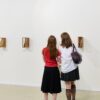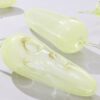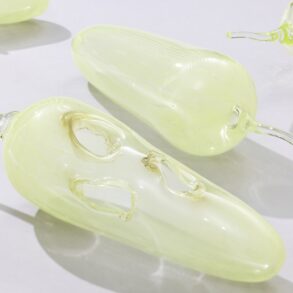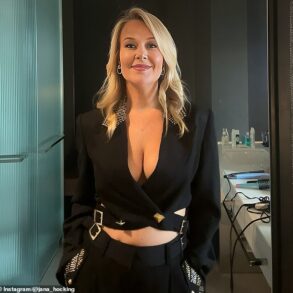By David D’Arcy
This is the first US museum exhibition for Paula Modersohn-Becker, and one of the crucial shows to see in New York this summer.
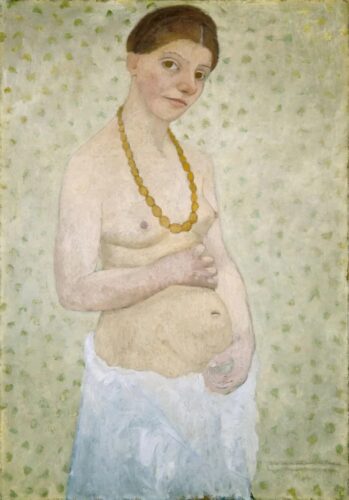
Self-Portrait on Sixth Wedding (Anniversary) Day, 1906. Photo: Paula Modersohn-Becker Stiftung
Paula Modersohn-Becker (1876-1907) painted landscapes and still lives that showed an eye for the art of her time and a hard-headed spirit to go beyond it. And she painted herself in portraits with a rare and gentle honesty. She was also stubbornly productive. Modersohn-Becker left some 700 paintings behind when she died at 31. She had sold three works while she lived.
An exhibition at the Neue Galerie in Manhattan through September 9, Paula Modersohn Becker: Ich Bin Ich/I Am Me, presents a resonant sense of what she achieved as well as the many directions she explored at a young age. It’s her first US museum exhibition, and one of the crucial shows to see in New York this summer.
Modersohn-Becker is said to have been the first woman to paint a nude self-portrait — where she is nude and pregnant. Back then exhibiting a work like that was bolder than painting it — the picture wasn’t shown. Her post-impressionist Mona Lisa smile — please forgive the cliché — conveys her determination. Neither defiant nor shy, the self-portrait’s brazen gesture isn’t what’s surprising — it is the image’s gentleness. Her contemporaries, Käthe Kollwitz and Max Beckmann, made self-portraits throughout their lives, some jarring but none of them nude. And. while Modersohn-Becker’s rocky biography suggests frequent if not constant anxiety, the pictures themselves seem to suggest that making them were acts of pleasure.
Young Paula Becker’s talents were evident early. Born in Dresden, she studied as a girl in London, but when she visited Paris Cézanne became a crucial influence. She became an adept imitator of Cézanne (and Gauguin), but her more personal still lives take melons and fruit apart, exploring the objects’ inner and outer textures with such detail that the paintings can feel like collages. She piled reddish impasto so thickly on the cheeks of Self-Portrait with Two Flowers in Her Raised Left Hand (1907) that the rouge on her face looks like cement – awkward but forgivable evidence that she was experimenting constantly.
The sculptor and prodigious draftsman Auguste Rodin, whom Becker met through the poet Rainer Maria Rilke, was another inspiration. Modersohn-Becker’s grand charcoal drawings, around six feet tall, have a sculptural feel to them. Other works in charcoal, like a portrait in profile of an old woman, can be precise to the point of grotesquery. They can also be playful, as we see in the defiant pose of a girl in the nude, which is more mockingly menacing than the girls depicted or sculpted by Edgar Degas, another influence.
Like many artists of her generation, Modersohn-Becker was moved by art from outside Europe. Fayum mummy portraits, which she saw in Paris, were a major influence on her depiction of her face in the self-portraits.
Settling in Worpswede, a hamlet in the rainy bogs outside Bremen where artists found an alternative to the academy, she married a painter ten years her senior, Otto Modersohn. The locals, especially children, became a subject. Her style turned distinctly atmospheric and colorful; her young subjects were depicted languidly, in paint that sometimes flowed like rain, as if the kids were creatures in formation. She felt that Impressionism, which she had encountered in France, was too pervasive to forget, although in these magical pictures she makes it work for her own purposes. One of my favorites, not in this show, is of three skinny nude blonde boys — nudes once again, and male — standing in waterlogged green grass next to a canal. It would be an understatement to call this a picture soaked with color. In the current show we see that she wasn’t limited to that kind of soft-focus. The radiant Head of a Blonde Child from 1905 has a delicate glow and a refined touch that evoke the 17th century.
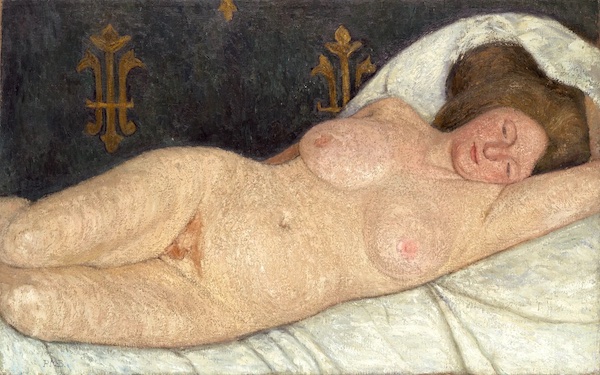
Paula Modersohn-Becker, Reclining Nude, 1905-1906. Photo: Doepfner Foundation
For drama, there was Modersohn-Becker’s personal life. An uncle had tried, unsuccessfully, to assassinate the King of Prussia. He ended up in prison, closing off opportunities for the artist’s respectable father, an engineer who discouraged her from pursuing art as a vocation. As for life in Worpswede, cohabitating with a husband and his young child proved to be less exciting than she had anticipated. It took five years for the marriage to be consummated; Becker departed for Paris whenever possible, sometimes with a reluctant Modersohn in tow. Worse, he didn’t think much of her paintings, infused as they were with all things – from color and energy to vistas of skin – which German art of the time lacked. Rainer Maria Rilke was a close friend of the artist, but their bond never went past friendship.
Paula moved out from Modersohn’s house, then came back, became pregnant, and had a child. Her pregnancy kept her bedridden and left her with thrombosis, which killed her at 31 in 1907. Rilke mourned her in the 1908 poem “Requiem for a Friend“: “For that is what you understood: ripe fruits. /You set them before the canvas, in white bowls,/ and weighed out each one’s fullness with your colors./ Women too, you saw, were fruits; and children, moulded/ from inside, into the shapes of their existence.” (an excerpt, translated by Stephen Mitchell).
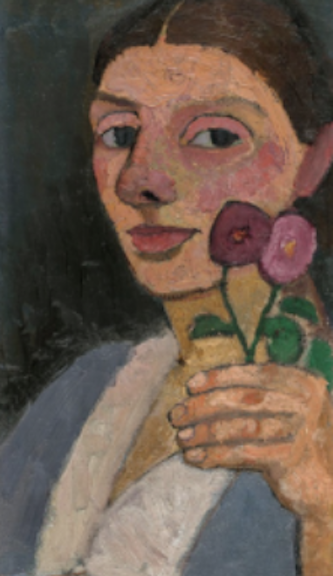
Paula Modersohn-Becker, Self-Portrait with Two Flowers in Her Raised Left Hand, 1907. Photo: MoMA
She has had a following since her death, including a museum in her honor in Bremen, a source for many works in the NYC show. Her acclaim, reinforced by her widely read letters and journals, has grown with the art world’s slow recognition of women artists.
This museum exhibition is wowing some critics. who see it as “revelatory.” But Modersohn-Becker was never a phantom. Galerie St. Etienne in New York first showed her work in 1958. In 2013, a biography from Yale University Press was reviewed on the front page of the New York Times Book Review. In 2016, Galerie St. Etienne presented another Modersohn-Becker exhibition, with works for sale in a country where few had ever been bought by museums. And, in 2017, the Museum of Modern Art in New York bought its first painting by Modersohn-Becker, Self-Portrait on Sixth Wedding (Anniversary) Day (1906).
In 1933, when the Nazis came to power, they selected works by German artists to be purged from the country’s museums. Paintings by Modersohn-Becker were among those shown in a 1937 exhibition dedicated to “Degenerate Art.” A sampling of the official critique: “Her vision is so lacking in femininity and so vulgar…Her work is an insult to German women and to our farming culture…Where is the sensitivity, the essence of the feminine-maternal spirit?…A revolting mixture of colors, of idiotic figures signifying farmers, of sick children, degenerates, the dregs of humanity.”
Given the source, you couldn’t ask for greater praise.
David D’Arcy lives in New York. For years, he was a programmer for the Haifa International Film Festival in Israel. He writes about art for many publications, including the Art Newspaper. He produced and co-wrote the documentary Portrait of Wally (2012), about the fight over a Nazi-looted painting found at the Museum of Modern Art in Manhattan.
This post was originally published on this site be sure to check out more of their content

